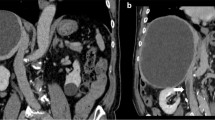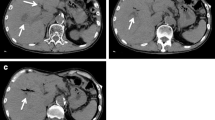Abstract
Peliosis hepatis is a rare benign condition characterized by oval or irregular, multiple blood-filled spaces within the liver parenchyma. It is most commonly seen in adults and may be idiopathic, but has various associations including malignancy, infection and drugs. The imaging findings are often non-specific and the condition may be mistaken for multiple abscesses, metastases or vascular malformations. Peliosis hepatis is an especially rare condition in children and to our knowledge only six cases have been described in the literature. Our case describes and illustrates peliosis in a 3-year-old girl and is the first described in any age group to cause complete IVC obstruction. The patient subsequently made a full recovery.



Similar content being viewed by others
References
Schoenlank FW (1916) Ein fall von peliosis hepatic. Virchows Arch [A] 222:358–364
Vignaux O, Legmann P, de Pinieux G, et al (1999) Hemorrhagic necrosis due to peliosis hepatitis: imaging findings and pathological correlation. Eur Radiol 9:454–456
Zafrani ES, Cazier A, Baudelot A, et al (1984) Ultrastructural lesions of the liver in human peliosis. A report of 12 cases. Am J Pathol 114:349–359
Bracero LA, Gambon TB, Evans R, et al (1995) Ultrasonographic findings in a case of congenital peliosis hepatitis. J Ultrasound Med 14:483–486
Cragg A, Castaneda-Zuniga W, Lund G, et al (1984) Infantile peliosis hepatis. A case report. Pediatr Radiol 14:340–342
Yanoff M, Rawson AJ (1964) Peliosis hepatic. An anatomic study with demonstration of two varieties. Arch Pathol 77:159–165
Crawford JM (1999) The liver and biliary tract. In: Robbins S, Angell M, Kumar V (eds) Basic pathology, 3rd edn. Saunders, Philadelphia, p 883
Kleinig P, Davies RP, Maddern G, et al (2003) Peliosis hepatic: central “fast surge” ultrasound enhancement and multislice CT appearance. Clin Radiol 58:995–998
Gouya H, Vignaux O, Legmann P, et al (2001) Peliosis hepatic: triphasic helical CT and dynamic MRI findings. Abdom Imaging 26:507–509
Steinke K, Terraciano L, Wiesner W (2003) Unusual cross-sectional imaging findings in hepatic peliosis. Eur Radiol 13:1916–1919
Smathers RL, Heiken JP, Lee JK, et al (1984) Computed tomography of fatal hepatic rupture due to peliosis hepatis. J Comput Assist Tomogr 8:768–769
Ferrozzi F, Tognini G, Zuccoli G, et al (2001) Peliosis hepatic with pseudotumoral and haemorrhagic evolution: CT and MR findings. Abdom Imaging 26:197–199
Jamadar DA, D‘Souza SP, Thomas EA, et al (1994) Case report: radiological appearances in peliosis hepatis. Br J Radiol 67:102–104
Maves CK, Caron KH, Bisset GS III, et al (1992) Splenic and hepatic peliosis: MR findings. AJR 158:75–76
Saatci I, Coskun M, Boyvat F, et al (1995) MR findings in peliosis hepatis. Pediatr Radiol 25:31–33
Verswijvel G, Janssens F, Colla P, et al (2003) Peliosis hepatic presenting as multifocal hepatic pseudotumor: MR findings in two cases. Eur Radiol 13:L40–L44
Jacquemin E, Pariente D, Fabre M, et al (1999) Peliosis hepatis with initial presentation as acute hepatic failure and intraperitoneal hemorrhage in children. J Hepatol 30:1146–1150
Wang SY, Ruggles S, Vade A, et al (2001) Hepatic rupture caused by peliosis hepatic. J Pediatr Surg 36:1456–1459
Author information
Authors and Affiliations
Corresponding author
Rights and permissions
About this article
Cite this article
Hiorns, M.P., Rossi, U.G. & Roebuck, D.J. Peliosis hepatis causing inferior vena cava compression in a 3-year-old child. Pediatr Radiol 35, 209–211 (2005). https://doi.org/10.1007/s00247-004-1311-8
Received:
Accepted:
Published:
Issue Date:
DOI: https://doi.org/10.1007/s00247-004-1311-8




